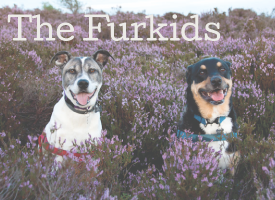There are two main types of stone walls. Dry and wet. Dry is loose stone stacked on itself. Wet is stone stacked using cement or mortar.
I've been told a "true" Englishman can tell what region of the country he's in by the stone and method used in a dry wall.
"Dales" are valleys. "Moors" are areas of poor drainage with thick, unruly growth.
Dales are usually bright and green, dotted with sheep. Moors are usually deep browns and reds, dotted with sheep.
The areas in the Yorkshire Dales are named according to the river that created the dale. For example, the River Nidd flows through "Nidderdale." The River Wharfe created "Wharfedale." The River Swale meanders through... you guessed it! "Swaledale."
You're likely to find anglers and dogs in most of the rivers at any time of day or year- but not together!
The movie "Calendar Girls" is based on a true story of some women from the village of Kettlewell, located in the heart of the Yorkshire Dales.
I saw and enjoyed the movie years before we moved here. A few months ago I was sorting through our dvds to pick something to watch and I landed on that one- it was a whole new movie now that I understand more of the jokes and have lived in the area myself!
"Area[s] of Natural Beauty" and "National Parks" are very different from what we know in the States. People can own land in them, farm them, and hunt on them- but there are more stringent rules and guidelines than in other areas.
I think ALL of North Yorkshire is an area of natural beauty- but I'm probably biased!
Yorkshire is divided into four parts: North Yorkshire, South Yorkshire, West Yorkshire, and East Riding. North Yorkshire is the largest county in England.
I've heard various reasons for the use of "Riding" and older maps and books will list "West Riding" in lieu of "West Yorkshire."
Sheep are painted with different colors and on different parts of their bodies to differentiate one farmer's flock from another.
In the fall, you may see a burly sheep with a thickly painted chest and many other sheep with a fainter tone of that color on their... umm... backsides. The rams are painted so as to mark the females they've mated with. I commented to a farmer I know that it seemed a bit unfair, that the ewes had to walk around for days with a very public "tag". He chuckled and said he'd never thought of it that way.
Sheep are painted with different colors and on different parts of their bodies to differentiate one farmer's flock from another.
In the fall, you may see a burly sheep with a thickly painted chest and many other sheep with a fainter tone of that color on their... umm... backsides. The rams are painted so as to mark the females they've mated with. I commented to a farmer I know that it seemed a bit unfair, that the ewes had to walk around for days with a very public "tag". He chuckled and said he'd never thought of it that way.
If you visit us, I'm full of these.
I'm sure it's delightful... although we've not had anyone return for a second visit yet.











No comments:
Post a Comment
Thanks so much for stopping by! I can't wait to read your comment!